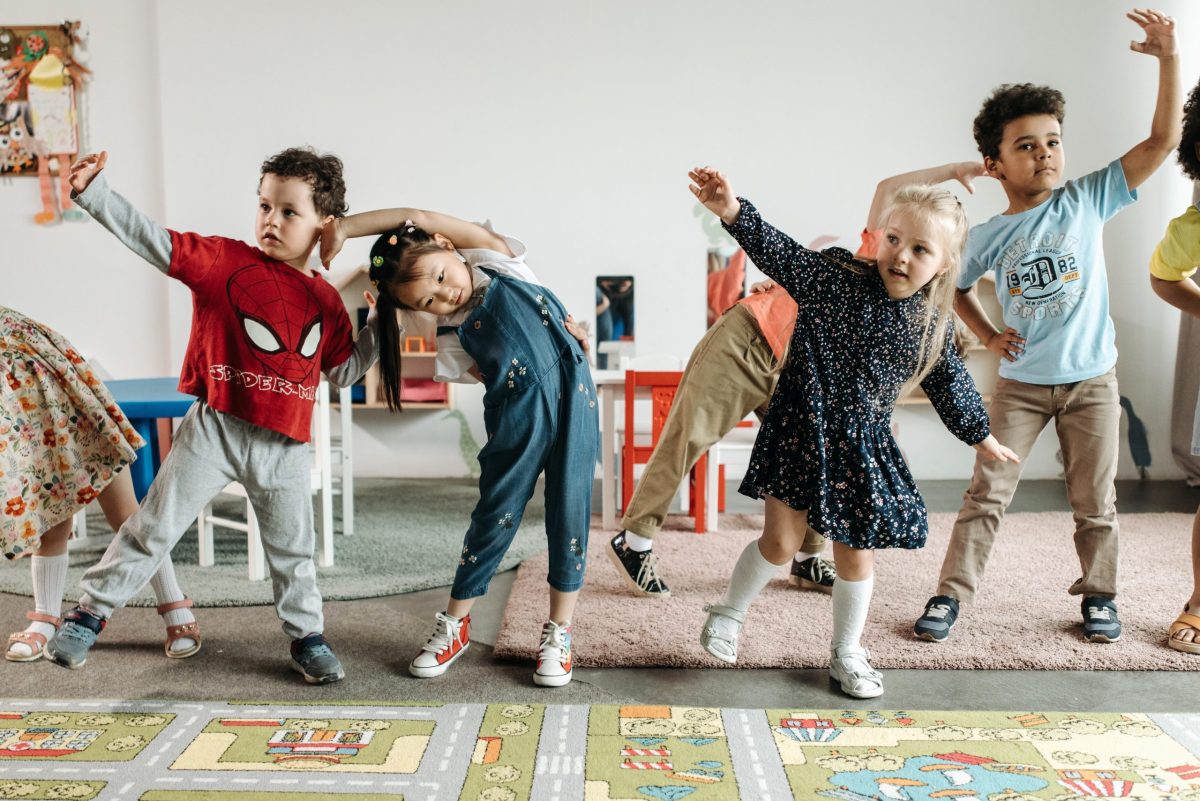Montessori Circle Time at Home
As parents and educators, knowing what to include in Montessori circle time at home can be daunting. Creating a circle time routine is a worthwhile endeavor, though, as it’s a special time of the day to come together, introduce topics, maybe listen to music, and generally enjoy each other’s company.
Here, we will explore some ideas to inspire you to create a fun Montessori circle time at home that works for your family.

Benefits of Montessori Circle Time at Home
There are no rights and wrongs when creating a routine for your circle time. Typically, a Montessori circle time will last between 20 to 30 minutes, depending on your child’s age, activities, and attention span.
When deciding what kinds of things to include in your daily circle time, ask yourself what you hope your children gain from circle time. While the answer to that question may change daily, considering your general goals can help you plan an effective routine. For example, if you want your circle time to prepare kids for the day, you might want to have it every morning. However, if you plan to read stories or play music in circle time, you may consider having it in the afternoon.
Circle times are fantastic opportunities for connection and catching up regardless of what activities you may do.
What to Keep in Mind for a Montessori Circle Time Routine
Here are some tips and things to keep in mind when implementing your circle time into your Montessori homeschool routine. While this list is not exhaustive, you can use it as a starting point to inspire you!
Where to Have Your Montessori Circle Time at Home
Choose a quiet place to have circle time. All you need is enough space for whoever is joining to sit. You can make it more comfortable and inviting with rugs and cushions. Ideally, we’d recommend doing your circle time in the same area each day, as the consistency gives children stability and helps them to have autonomy over their routine. However, don’t be too worried about adapting if the area you originally chose doesn’t work for you — you can switch it up as needed. Just try and keep it consistent when possible!
Warm-Ups and Cool Downs
 Keep circle time exciting, and start it the same way each day. That way, children understand it’s time for circle time. Sing the same opening song or same dance.
Keep circle time exciting, and start it the same way each day. That way, children understand it’s time for circle time. Sing the same opening song or same dance.
You can keep your circle time routine exciting using Montessori songs, movement, and music to warm up and cool down similarly each day. The specific activities can change, but keeping some consistency is a good idea. Here are some ideas to get everyone’s bodies moving and vocal cords working each day:
- Get Together Songs (We recommend keeping the same one for a couple of weeks at a time, like Make a Circle or a Circle Time Transition Song.)
- Wake Up Song
- Shake Your Sillies Out
- Bend and Stretch Cool Down
Movement is a powerful tool for connection and regulation. If these ideas interest you, check out Montessori By Mom’s Movement and Motion Toolbox for more activities!
When to Have Circle Time
Before planning your circle time activities, it’s a good idea to choose a specific time of day for your circle time. You could even decide to plan a couple throughout the day.
Will you open your homeschool routine with a circle time in the morning? In this case, you might want to talk about your children’s goals and feelings about the day. Are you going to use your Montessori circle time routine to break up the day? In this case, you could use this time to reflect or introduce a relevant topic from your day.
Your activities will probably depend on where you choose to add circle time to your routine. Think about when is best for your family to sit down and talk, move, and do circle time activities together.
What to Include in Montessori Circle Time at Home

You can include many things in your routine, and you’ll notice what works for you and your family as you go. One classic circle time idea is a calendar to introduce the days of the week, the weather, and the months. For the weather, you can take the activity a step further by grabbing a camera and taking pictures of different kinds of weather. Once you’ve compiled your images, turn them into flashcards for circle time.
Other favorite circle time topics include colors, numbers, seasons, and everyday life. An opening and closing boxes game is perfect for problem-solving and refining fine motor skills.
Remember, fun, simplicity, and adaptability are key!
Time
Attention spans vary. Still, on average, your Montessori circle time routine should be around 20 minutes max for children ages 3-6 and 10 minutes for younger children. As kids get older, they can spend more time sitting down and engaging, and even lead circle time some days. Still, it’s worth keeping in mind that some days will be shorter and some longer, so keep it simple and be ready to adapt.
Adaptable Ideas for Montessori Circle Time at Home
- Check-in with each other’s feelings and emotions. Using a book like The Color Monster can help children explore these abstract concepts.
- Choose the same opening and closing song for every circle time.
- At certain times of the year, you can introduce seasonal concepts like harvest, spring flowers, summer solstice, winter holidays, American Independence Day, World Ocean Day, etc.
- Use musical instruments and learn about rhythm and beat.
- Explore positive discipline and talk about struggles you may have faced that day, like sharing, focus, or sibling rivalry.
- Discuss upcoming field trips or vacations.
- Use a calendar to talk about days of the week and seasons.
- You could explore the topic of friendship and how to treat others.
- Introduce new topics like the life cycle of a plant with a Shoots and Sprouts toolbox.
- Tie topics and activities into books. For example, if you’ve been learning to count, you can read a book that helps kids practice these skills.
- Explore your family tree with images, special objects, and books.
- Bake some bread in the morning and share it during your Montessori circle time routine.
- Sing songs together.
- Explore the world around you and introduce different cultural foods, countries, maps, and flags.
- If you’re a bilingual or a multicultural family, you can think about sharing your culture with pictures, objects, stories, and language. Even if you’re not, plenty of books and resources are out there.
- Plan a movement activity or put some music on and dance together.
- Discuss and bring up important events that might be coming up in your calendar. This way, everyone is on the same page.
Sample Montessori Circle Time Routines
Now that we’ve covered the basics of a Montessori circle time routine, you may be wondering how to put it all together. We’ll walk you through a few step-by-step examples of what this may look like at home. Remember, you can customize your circle routine to your family’s preferences and needs — these examples are just to get you started!
Example 1: Once the children have gathered, the parent sings a familiar song that cues the beginning of circle time. This ritual can make the transition to circle time run more smoothly.
Then, the parent talks about what day of the week it is. They may sing a days of the week song like this one, reviewing all the days of the week before saying something like, “Today is Wednesday.” Next, they may sing a song about the months of the year before saying, “The date is November 22.” The parent may also talk to the children about what the weather is like that day.
Next, the parent presents a simple grace and courtesy lesson, like talking about how to greet visitors or how to clean up after themselves. If time allows, the parent may also present a work that’s relevant to the season or what the children are learning.
When it’s time to close circle time, the parent sings another song to end circle time.
Example 2: The parent sings a song, talks about the day of the week and the date, and reviews the weather, like in the example above.
Since this is a homeschool setting, the parent also presents a brief agenda for the day and helps set the child up for success. For example, the parent may say, “Today, we are going to visit a farm. This is how we can be respectful of the animals and farmers.”
Before ending circle time, each child chooses a book to read with the parent.
Conclusion
We hope planning a Montessori circle time routine now feels a little less daunting and that we’ve inspired you with some ideas. While your circle time routine may not look perfect or run smoothly every day, embrace the imperfections and remember that it’s just a time for connection; however that looks for you!
Let us know which ones you’ve tried in the comments; we love to get your inspiration, too!




0 Comments